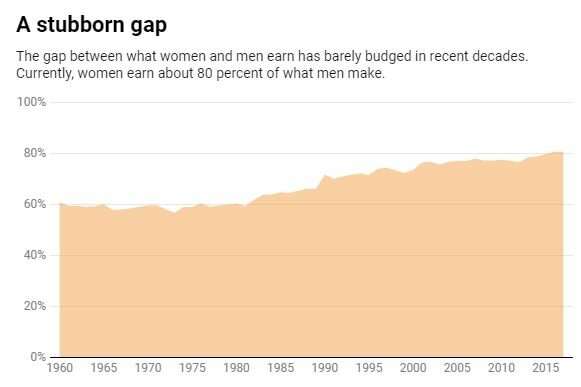Why women still earn a lot less than men

A decade ago, on Jan. 29, 2009, newly inaugurated President Barack Obama signed his first bill into law: the .
It was the latest legislative effort to close the persistently stubborn gap between how much women and men earn. At the time, of every dollar men earned – a level that hadn't improved all that much since the 1990s, according to Census data.
While existing laws already prohibited gender-based wage discrimination, the Ledbetter Act gave workers more time to sue employers over the issue. And the hope was that it would make a big difference.
So did it?
explores the legal hurdles that have prevented women from achieving pay equity with men. Now, 10 years after the act was passed, more work still needs to be done.
Ledbetter's complaint
The Ledbetter Act overturned a that ruled against Lilly Ledbetter, who worked as an area manager at Goodyear Tire and Rubber for more than 19 years. Over time, her pay slipped until she was earning 15 percent to 40 percent less than her male counterparts.
When an off about the extent of the disparity, Ledbetter filed a pay discrimination complaint under , a statute prohibiting employment discrimination on the basis of sex, race, color, national origin and religion. A jury found in her favor and awarded more than US$3.5 million in damages.
The case was appealed all the way to the Supreme Court, which in 2007 that employees must file a complaint within 180 days after their employer makes a pay decision. The fact that the discrimination was embedded in each paycheck and that Ledbetter didn't know of the disparity for many years did not matter. Time had run out on her claim.
In a read from the bench, Justice Ruth Bader Ginsburg noted that the ruling denied workplace realities. She pointed out that since employees often lack information about pay disparities, which can accumulate slowly over time, they shouldn't be given such a narrow window in which to file a complaint.
Ultimately, the 111th Congress and President Obama agreed with Justice Ginsburg and nullified the decision. The makes clear that the statute of limitations for filing a wage discrimination claim resets with each discriminatory paycheck.
A disappointing impact
The law's impact, however, has been disappointing.
The rate of new wage discrimination cases , primarily because employees still about their co-workers' pay. Salary discussions in most workplaces, and some employers, like Ledbetter's, .
Put simply, a woman can't file a complaint if she doesn't know she's being shortchanged.
Title VII wage claims are hard to prove for other reasons too. Title VII generally requires proof that employers acted with discriminatory intent. However, much discrimination in today's workplace is not intentional but fueled by unconscious gender stereotypes.
For instance, studies show that when they conform to gender stereotypes, such as dominance for men and passivity for women. In , participants were asked to award merit-based bonuses to fictional employees with identical personnel files. Men got higher bonuses than women.
The bottom line: Women today for every dollar men make earn, up just a few cents since 2009.
And for women of color, the . Latinas earn 52 cents to the dollar of white men, while African-American women earn just 61 cents. Within racial groups, a , although it is narrower.

Narrow interpretations
Of course, employees who believe they are being discriminated against based on gender can also turn to the . This act, signed into law in 1963 when women earned only 60 cents for every dollar men earned, does not require a showing of employer intent to discriminate.
The act was the first to from paying men more than women who perform equal work.
The pay gap has since narrowed by about 20 cents, but not because of anti-discrimination laws. The have been women's increased educational attainment and entry into the workforce.
The Equal Pay Act hasn't been effective because . They generally require that women plaintiffs identify a man with an identical job and resume for comparison. Given that men and women are tracked into different occupations, this can often be impossible.
Moreover, both Title VII and the Equal Pay Act allow employers to defend pay differentials on the basis of "any factor other than sex." For example, a limitless array of employer excuses for paying women less that are themselves rooted in gender bias, such as women's weaker salary bargaining skill, lesser management potential or lower prior salary history.
These statutory interpretations may sound technical, but they matter. the gap appears stuck at 80 cents and why it'll be until pay equity in the United States is reached.
Why it persists
Another reason the gap is so stubborn is that men and women are steered into , and for comparable work.
Even within a traditionally male field such as computer programming, women are paid less. And, as women move into a field, the .
Importantly, economists have found that as much as 38 percent of the gender gap.
Skeptics of the gender gap argue that it results from and stay home to raise children.
It's true, women bear a and thus may cut back their hours or take time off from the workplace – especially because the United States is the and child care is .
But while mothers face a "" in opportunities and pay, fathers reap a "."
And so-called "choices" cannot explain why female are paid 82 percent of their male counterparts or why the gap widens at the top. Professional women with advanced degrees who work full-time face a .
Closing the gender gap
Closing the gender pay gap is not rocket science – even though recently graduated female rocket scientists to their male peers.
Steps that would help include prohibiting employers from using salary history in setting wages, banning employer retaliation against employees who share wage information, providing greater transparency in pay, and revising Title VII and the Equal Pay Act to better address workplace realities.
The proposed – introduced repeatedly in Congress since 1997 but never passed – would codify many of these remedies at the federal level. And the an Obama-era requirement that employers report extensive pay data.
While federal efforts stall, several states, including California, Oregon, Massachusetts, Maryland and New Jersey, to close the gap.
The economic gains from closing the gender pay gap are huge. Doing so to the economy because of the extra income generated, and do a lot to support American families since mothers are the in about half of them.
Passing the Lilly Ledbetter Act was a start, and now we owe it to American workers to enact laws that close the gap once and for all.
Provided by The Conversation
This article is republished from under a Creative Commons license. Read the .![]()




















